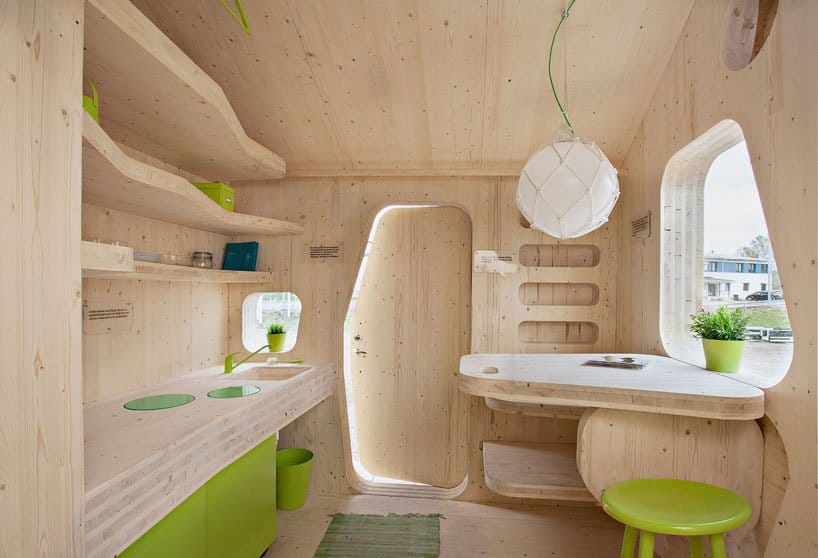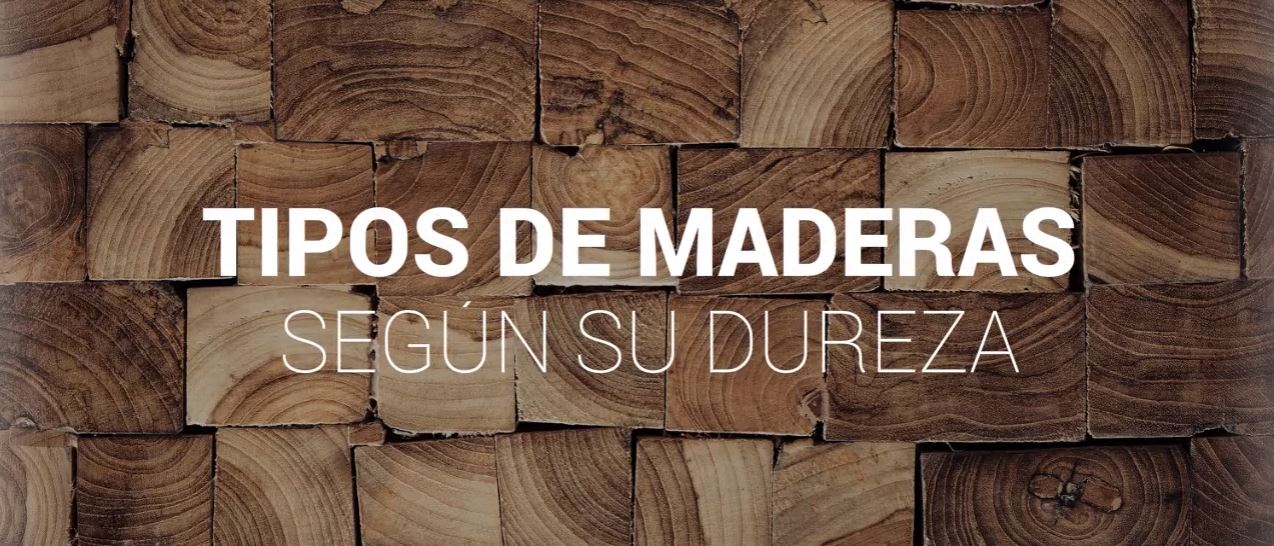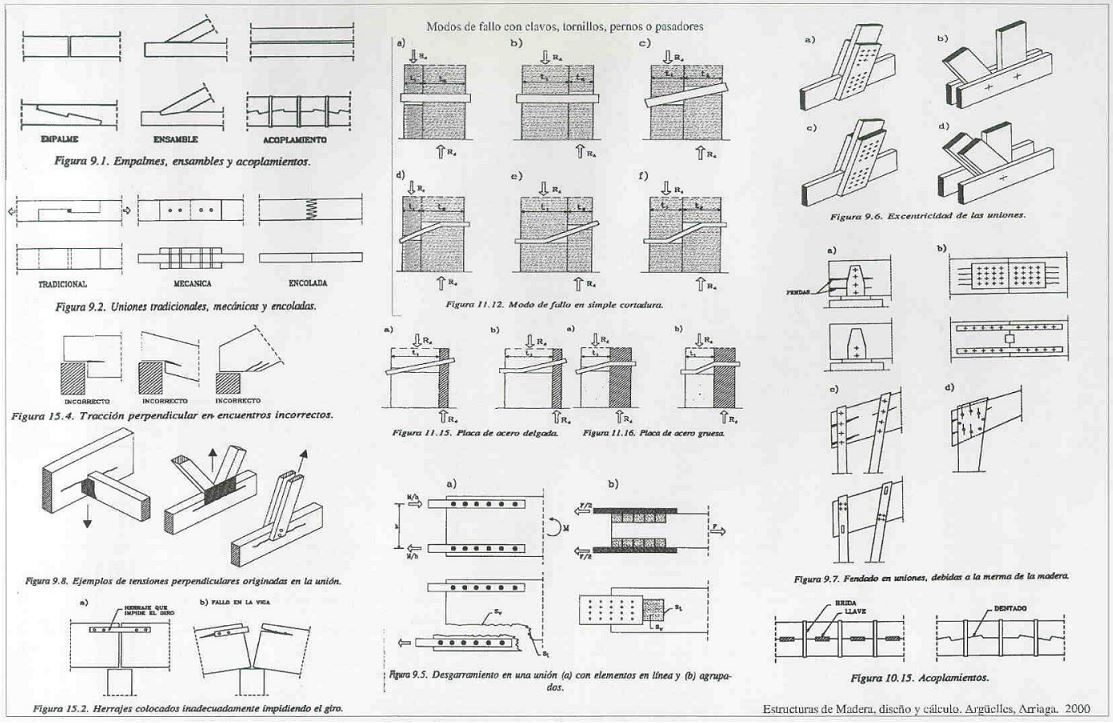Wood in architecture, construction and works
The art of wooden architecture is more alive than ever in a world of technological materials that dominate the market and that are undoubtedly the big competitors of the noblest woods .
The wooden constructions have reached its modern splendor with architects and designers who risk for traditional materials but with renovation techniques that enhance construction with sleepers, boards and battens to its maximum splendor.
The cover photograph represents a Low Cost home presented at the wooden exhibition “ Virserums Konsthall ” Designed by Tengbom Architects in collaboration with AFB and the timber company Martinson.

Whose objective was to build a wooden house affordable and sustainable for students . A purpose which was carried out with excellent results, an example of utility and current use in architecture where wood is the main protagonist of this story.
Content menu:
- Architecture with wood
- Advantages of wood in its use
- Main disadvantages of wood
- Physical and mechanical properties of wood
- Types of construction wood
- Wooden structure:
- Wood construction and architecture manuals:
Architecture with wood
The construction with wood is having a positive impact on the end user where finds in this material sensations of comfort and comfort that other materials are not achievable. Affordable wooden houses and well-designed make up a rising market.
Many models dominate the market, some more attractive than others but we want to show the ideas of a Australian architect specialist in building wooden houses , it's called Jackson Clements Burrows . A multitude of awards endorse it and it is that his works offer a different look at the world of the architecture:

Some houses built with wood of the which could we say… I want one! You have to remember that most wooden houses are made with prefabs and modules. It is this sense we already spoke in the manufactured housing article that we reeled off every ins and outs of the prefabricated houses of wood and other materials.
The following video explores the future of wood in structures and their consequences. with interesting reflections!…
Advantages of wood in your use
It should be noted that the advantages of wood are much greater than its disadvantages as a material.
- It is a natural product. It is a product of natural origin, recyclable and renewable, whose production process in relation to other industrialized products offers less waste, requires low energy consumption and respects nature and environment. Current employment is not toxic, no produces odors or toxic vapors of chemical origin, in Consequently, it is safe to touch and handle. It is also a easy material to work with.
- It is 100% renewable if trees are felled in forests properly and with certificates relevant. New trees are planted careful and without compromising natural resources.
- Good insulation. Isolation is one aspect very important for the reduction of the energy used in the heating and air conditioning of buildings. wood is a natural insulator that can reduce the amount of energy necessary for the air conditioning of spaces, especially when It is used in windows, floors or doors. presents great natural conditions of thermal insulation and absorption acoustic.
- Facilities in the work of management and structure. It is about of a very versatile raw material that can be used in a varied way and that complies with certain specifications and needs, according to the type of desired application. Leave simple connections and splices of execute even complex structures with a suitable execution.

- A material that lasts. The use of wood under construction well treated, provides durability, a beam, a log or batten, or the simple Naughty in need of some maintenance. Examples of durability there are many; sarcophagi, statues, family gear, weapons, boats, instruments, construction elements.
- Easy to find and relatively priced economical in relation to other materials.
- Employment utility with different forms. Could be produced in pieces with structural dimensions of any size, it can be used in industrialization or on delicate items.
- 100% reusable. ability to be turned to use multiple times and without excess material. (A perfect example, are the furniture with pallets recycled and how to make a geodesic dome)
- Structural properties. able to resist to both compression and tension sacrifices. Has a low density, low mass and high mechanical resistance. The resistance to bending can be more or less about ten times higher than that of concrete. Doesn't come undone when touched subjected to sudden blows that can cause damage to others building materials.
- Diversity of textures and finishes. In its natural appearance offers a huge variety of patterns, whether smooth, wavy, rough…etc.
Main disadvantages of wood
- Variability in quantity. It is highly sensitive to environment, increasing or reducing its size before changes in humidity.
- Vulnerability. against elemental attacks external, for example water, its durability and hardness is limited when precautionary measures are not taken appropriate.
- It is very fragile against fire, forming an element «fuel in structures». A good way to prevent possible adversities is with a fire detector or some type of smoke detector.
- Reduced size and dimensions if we work from the architecture perspective.
Variability in strength and hardness. It is not the same slats from the pine that the oak beams in a structure or for cutting, to give an example. One has to look for its usefulness, technique and use for each function, be it for interior in carpentry or decoration, for exterior, in structural frameworks …etc.
Physical and mechanical properties of the wood
I would like to add a schema with; first, one one comparison with other construction materials, and, later, a diagram of the mechanical properties of the wood.
- Hardness: The resistance it presents when drilled with some metallic elements or certain machinery. This hardness is achieved in woods with little water content extracted from old trees.
- Density: Refers to its resistance, being subjected to bending or compression processes.
- Hygroscopity: It is when it absorbs or releases humidity by capillarity.
- Thermal and electrical conductivity: It is when it works as an insulator in the field of electricity.
- Texture: refers to the physique it presents, such as the carvings, color, types of sanding … etc.
If you want more information about the characteristics of how works on pillars, beams, foundations, etc. you can consult this manual from HERE. And we leave the next excellent video about the myths that circulate about this material so noble:

Types of wood for construction
Although current technology is providing a wide range of typologies where even materials are added extra that match perfectly, we can classify them into:
- M. Natural noble or hard . They are those heavy and resistant, which normally come from trees that have slow growth (Examples like Chestnut, Cherry, Ebony, Olive, Ash, Beech, Walnut, Oak…etc)
- M. Natural soft . The growth of trees is much faster, so your resistors they are softer and the sale of the same is more economical, low prices in relation to the previous one. For example, the pine would enter.
- Artificial wood . They are produced by chips or sheets suitably combined. where the plywood, chipboard, fiberboard (DM and DB) and the tables.
Wooden structure:
Not only wood is used as an instrument anymore to mold concrete, in interior design or in small buildings.
Increasingly, designers are daring with buildings in height and wooden structures almost impossible. As example in Spain we can find it in the historic center de Lleida – holds the record for the tallest building in Spain – built with wood.
The building has five floors plus the ground floor, which in practice means six floors. So far there is only single-family houses or two-story houses maximum in one country poured with concrete for structures.
Better than watching a video on assembling wooden structures for a building with several floors, at the end of the article are provided different manuals and techniques for the construction of wooden houses :
Currently if we remember correctly, the oldest building tallest of the world built in wood is in London, called the Stadhaus Tower N1, measuring 17 m x 17 m, is supported on a reinforced concrete foundation and the first floor was built in concrete.
The rest of the structure consists of a “beehive” of solid laminated wood panels that fulfill the function of load-bearing walls, enclosures, distribution and carpentry as a whole they form an exceptional framework. (More information of the company that is dedicated to constructing wooden buildings from their projects HERE)

But the ability of architects is to surprise and in this case from the USA through the architecture studio Michael Green who proposes wooden skyscrapers , pretending to reach 20 floors, they even consider up to the 30 plants (See also article on ranking of tallest skyscraper in the world).
A very risky idea where many detractors question doubt the sustainability of the construction given the amount so high amount of raw material needed. The study gives us the complete project of how it should be built wooden skyscrapers, see in this PDF… With info HERE)


As in this case, we are lighter, and we have wanted to compile a series of manuals or guides for construction and architecture in wood , houses, single-family homes, techniques on beams, sleepers, boards, joints, structures or to the understanding of the world of wood on site…
Construction and architecture manuals in wood:
- The construction of wooden houses ( Wood Technological Transfer Center CTT – Chile. With many chapters in PDF for learn.
- INDEX + INTRODUCTION
- Unit 1: WOOD
- Unit 2: PATHOLOGIES AND PROTECTION OF WOOD IN SERVICE
- Unit 3: RELEVANT ASPECTS TO CONSIDER IN A PROJECT OF CONSTRUCTION OF HOUSING
- Unit 4: SAFETY AND PREVENTION OF CONSTRUCTION RISK
- Unit 5: TOOLS AND INSTRUMENTS
- Unit 6: SYSTEMS STRUCTURAL
- Unit 7: FIXINGS AND UNIONS
- Unit 8: FOUNDATION
- Unit 9: FRAMES HORIZONTAL
- Unit 10: FRAMES VERTICALS
- Unit 11: STRUCTURE OF ROOFING
- Unit 12: STAIRS
- Unit 13: ASPECTS OF HABITABILITY
- Unit 14: ISOLATION AND VENTILATION
- Unit 15: PROTECTION AGAINST FIRE
- Unit 16: CONSIDERATIONS IN THE DESIGN AND EXECUTION OF THE FACILITIES IN A HOUSING
- Unit 17: SOLUTION OF ROOF IN WOOD
- Unit 18: WOOD CLADDING FOR EXTERNAL WALLS
- Unit 19: COATING SOLUTION SKY AND INTERIOR WALLS
- Unit 20: WOOD CLADDINGS AS A FLOOR SOLUTION
- Unit 21: FINISHING WITH MOLDINGS DECORATIVE WOOD
- Unit 22: DOORS AND WINDOWS
- Unit 23: MANAGEMENT OF QUALITY
- ANNEX 1
- ANNEX 2
- ANNEX 3
- ANNEX 4
- ANNEX 5
- ANNEX 6
- ANNEX 7
Access to all documents from HERE.
- The issue of joints in structures on planks, boards and beams is complex, both in terms of treatment of the cut, the edges as in the finishes of Union, whether for interior, exterior or in the carpentry itself of a house. So, the following manual of wood construction is just about that, in They are actually schematic files that, although a bit old they are of great quality. Access from HERE (In the part upper right there are about 5 tiles like the following, only you have to click on the small images)

- From Feim.org (Fonfederation Company) They offer us a series of manuals about wood quite interesting as:
- – Basics of building with wood
- – Wood products for the construction
- – Behavior against fire
- – Execution, control and maintenance
- – Joints in steel structures wood.
- – The wooden structure for roofs housing and renovations.
- – Durability.
- Guide to structural design – architecture… in wood HERE
- Wooden products for architecture (AiTim in collaboration with the Superior Council of Architects of Spain)… With information HERE
- Thesis. Construction of homes in wood … An efficient alternative?… Look HERE.
- From Infomadera we can access different manuals, guides, videos...etc (From HERE). As example of some manuals of wooden houses PDF :
- Book Wooden houses I General
- Book Wooden Houses II Wooden Houses trunks
- Book Wooden houses III Half-timbered houses heavy
- Book Wooden houses IV Half-timbered houses light
- Book Wooden houses V Lattice
- Book Casas de madera VI Means of union
- Book Wooden houses VII Insulation and waterproofing
- Book Wooden houses VIII Calculation structural
- Book Wooden houses IX Bibliography
- How to choose a log house, by Augusto Crossed
We only intend to make known the good virtues and types of wood as a material which is acquiring a greater role in the modern architecture for large volume buildings, We hope that the manuals and guides are useful.
Points of interest:
- Bioclimatic design manual.
- Plastic in modern architecture.
- Innovative materials for architecture.
- The form of architecture encouraged by the wind and the sun.
- How to design urban planning with manuals.
- Biosustainable or sustainable architecture with more than 20 manuals
If you liked the article, rate it and share!







